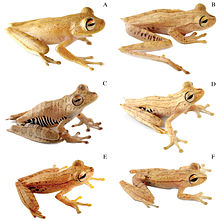Boana maculateralis
| Boana maculateralis | |
|---|---|

| |
| Scientific classification | |
| Domain: | Eukaryota |
| Kingdom: | Animalia |
| Phylum: | Chordata |
| Class: | Amphibia |
| Order: | Anura |
| Family: | Hylidae |
| Genus: | Boana |
| Species: | B. maculateralis
|
| Binomial name | |
| Boana maculateralis (Caminer and Ron, 2014)
| |
| Synonyms[1] | |
| |
The stained tree frog (Boana maculateralis) is a frog that lives in Ecuador, Colombia, and Peru. Scientists have seen it between 186 and 354 meters above sea level.[1][2]
The adult male frog is 31.9 to 39.2 mm long from nose to rear end and the adult female frog is 32.0 to 55.3 mm long. This is a medium-sized frog with large eyes and large climbing disks on its toes. The adult male frog measures 31.9 to 39.2 mm in snout-vent length and the adult female frog is 32.0 to 55.3 mm. It has light brown skin with darker marks. Some frogs have a single line from the head to the middle of the back. Some frogs have small brown spots. Larger females have blue color on their sides. Males have ligher or white color on their sides. This frog has two spikes near its rear end. Male frogs have a spike on their front feet for fighting each other. They also use it to hold onto females when they mate.[2]
This frog is sympatric with Boana calcarata, Boana alfaroi, Boana calcarata and maybe Boana tetete. This means that all these frogs came from the same ancestor frog species, and they became different species even though they all lived in the same place the whole time.[2]
This frog hides during the day and looks for food at night. It lives in forests. Scientists have seen it sitting on plants 2 meters above the ground.[2]
The Latin name of this frog means "stains on its sides."[2]
References[change | change source]
- ↑ 1.0 1.1 "Boana albopunctata (Caminer and Ron, 2014)". Amphibian Species of the World 6.0, an Online Reference. American Museum of Natural History. Retrieved August 28, 2021.
- ↑ 2.0 2.1 2.2 2.3 2.4 Diego A. Ortiz; Santiago R. Ron (August 1, 2014). "Boana maculateralis" (in Spanish). Amphibiaweb. Retrieved August 28, 2021.
